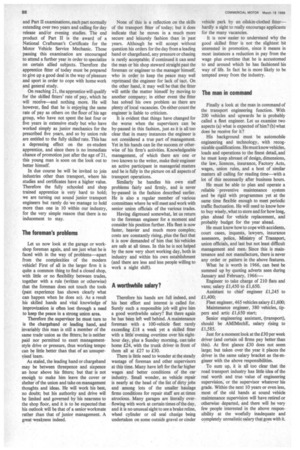Out-of-date attitude
Page 89

Page 90

If you've noticed an error in this article please click here to report it so we can fix it.
It can only be fair comment at this juncture to mention that in 1966 this 3d. per hour is still with us, and that hundreds of such supervisors are just three packets of cigarettes better off than the fitters they are expected to control.
How can our industry expect this out-ofdate attitude to encourage the right type of man to take the first step on the ladder of responsibility?
We have looked back at those so-called "Good Old Days", with their long hours and always a seven-day week in transport. It can be said with little fear of contradiction that from those hard and competitive days sprang the chargehands, foremen and engineers who are still the backbone of today's transport network. But their status has not kept pace with the times; their salary is equalled and often submerged by the weekly "take" of both drivers and fitters. This, I would add, at a time when the need for sound engineering skill, forward planning and good staff control is absolutely essential. This situation has been placed before management on many occasions. There appears to be a stock answer, that you take your apprentices with their college certificates and build them up to leading hands and chargehands. Let us take a look at the apprentice transport fitter of 1966; in all probability he will have been carefully selected, with close regard to his school report, and if he is a secondary modern A stream pupil he will have little difficulty in stepping straight into a technical college first-year course for motor vehicle mechanics.
This is the start of a four-year course that will lead him to the City and Guilds Part I and Part II examinations, each part normally extending over two years and calling for day release and/or evening studies. The end product of Part II is the award of a National Craftsman's Certificate for the Motor Vehicle Service Mechanic. Those passing this examination are encouraged to attend a further year in order to specialize on certain allied subjects. Therefore the apprentice fitter of today must be prepared to give up a good deal in the way of pleasure and sport in order to cope with home work and general study.
On reaching 21, the apprentice will qualify for the skilled fitters' rate of pay, which he will receive—and nothing more. He will however, find that he is enjoying the same rate of pay as others on the floor of his age group, who have not spent the last four or five years in extensive study but who have worked simply as junior mechanics for the prescribed five years, and so by union rule are entitled to the fully skilled' rate. This has a depressing effect on the ex-student apprentice, and since there is no immediate chance of promotion just after the age of 21, this young man is soon on the look out to better himself.
In due course he will be invited to join industries other than transport, where his studies and certificates have a higher value. Therefore the fully schooled and shop trained apprentice is very hard to hold; we are turning out sound junior transport engineers but rarely do we manage to hold more than one in 10 within our industry, for the very simple reason that there is no inducement to stay.




































































































































































